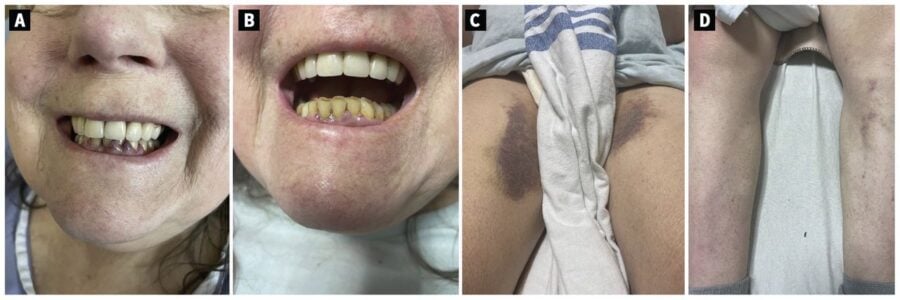A recent case study of a 65-year-old woman in Toronto reveals that scurvy, long associated with 18th-century sailors, remains a health concern in the 21st century. This vitamin C deficiency, linked to food insecurity and social isolation, challenges our assumptions about nutrition in modern society.
Summary: A case of scurvy in a 65-year-old woman highlights how vitamin C deficiency persists in modern times, often linked to food insecurity and social isolation. The study emphasizes the need for clinicians to consider scurvy when diagnosing patients with unusual bleeding and nonspecific symptoms.
Estimated reading time: 6 minutes
Scurvy, a disease caused by severe vitamin C deficiency, is often relegated to history books as a malady of long-ago sailors. However, a recent case study published in the Canadian Medical Association Journal (CMAJ) on October 7, 2024, brings this condition into sharp modern focus.
The study details the case of a 65-year-old woman who visited a Toronto emergency department with leg pain, weakness, and unusual skin lesions. Her diagnosis? Scurvy – a condition many might assume disappeared with the advent of modern nutrition.
The Modern Face of Scurvy
Dr. Sarah Engelhart, a general internist at Mount Sinai Hospital and the University of Toronto, who was involved in the case, stated, “This case presents a complex example of food insecurity manifesting as an uncommon diagnosis. A unifying diagnosis was uncovered only after a detailed assessment of her social and dietary history.”
The patient’s situation paints a vivid picture of how scurvy can develop in contemporary society. With mobility issues limiting her ability to shop for groceries and cook, and little outside support, she subsisted mainly on canned soup and fish, with no fresh produce. This restricted diet, combined with her smoking habit, created the perfect conditions for vitamin C deficiency.
More Common Than We Think
Surprisingly, vitamin C deficiency is not as rare as one might expect in the 21st century. Studies show a 5.9% prevalence in the United States, with rates potentially reaching as high as 25% in some low socioeconomic groups in the United Kingdom. These statistics highlight a hidden nutritional crisis in developed nations.
The challenge lies in diagnosis. Symptoms of scurvy are often nonspecific – fatigue, weakness, and shortness of breath – making it easy to overlook or misdiagnose. In this case, the patient’s skin lesions were initially mistaken for a fungal infection.
Risk Factors and Warning Signs
Clinicians are urged to be alert to vitamin C deficiency in several at-risk groups:
- Individuals with restrictive eating patterns (e.g., those with autism spectrum disorder or on a ‘tea and toast’ diet)
- Cigarette smokers
- People with substance use disorders
- Those with malabsorption syndromes
- Isolated older adults
- Children in food-insecure households
The authors emphasize the importance of assessing for food insecurity, which affects about 1 in 5 Canadian households and is a significant risk factor for scurvy.
Diagnosis and Treatment
In this case, the patient’s symptoms improved once she started vitamin C treatment. A subsequent blood test confirmed the scurvy diagnosis. This underscores the importance of considering vitamin C deficiency in patients with abnormal bleeding and nonspecific symptoms, especially when combined with risk factors like social isolation or limited diet.
Broader Implications
This case study serves as a wake-up call to the medical community and society at large. It highlights how social determinants of health – including food security, mobility, and social support – play crucial roles in nutrition-related diseases.
As we grapple with increasing rates of social isolation, particularly among older adults, and persistent food insecurity even in wealthy nations, the reemergence of scurvy as a health concern demands attention. It calls for a more holistic approach to patient care, one that considers not just symptoms but also lifestyle and social factors.
The study also raises questions about our food systems and societal support structures. How can we ensure that all members of society, especially the vulnerable, have access to a varied and nutritious diet? What role can community support programs play in preventing such nutritional deficiencies?
As we move forward, this case reminds us that even in our modern world, basic nutritional deficiencies can still occur, often hidden in plain sight. It underscores the need for vigilance, comprehensive patient assessment, and addressing the root causes of food insecurity and social isolation.
Quiz: Test Your Knowledge
- What was the main dietary restriction that contributed to the patient’s scurvy?
- What percentage of the U.S. population is estimated to have vitamin C deficiency?
- Name one group of people who are at higher risk for vitamin C deficiency according to the article.
Answers:
- She subsisted mainly on canned soup and fish, with no fresh produce.
- 5.9%
- Any of the following: Individuals with restrictive eating patterns, cigarette smokers, people with substance use disorders, those with malabsorption syndromes, isolated older adults, children in food-insecure households.
Further Reading
Glossary of Terms
- Scurvy: A disease resulting from a deficiency of vitamin C, characterized by swollen bleeding gums and the opening of previously healed wounds.
- Hypovitaminosis C: Medical term for vitamin C deficiency.
- Food insecurity: The state of being without reliable access to a sufficient quantity of affordable, nutritious food.
- Ecchymosis: A discoloration of the skin resulting from bleeding underneath, typically caused by bruising.
- Claudication: Pain caused by insufficient blood flow to muscles during exercise.
- Perifollicular petechiae: Tiny round brown-red spots around hair follicles due to bleeding under the skin.
Enjoy this story? Get our newsletter! https://scienceblog.substack.com/


